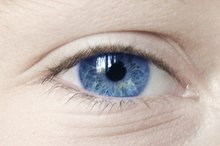What Causes Eye Mucus?
Eye mucus, or eye discharge, occurs when the external eye structures become irritated, triggering an inflammatory response. The discharge is characteristically thicker than tears and varies in quantity, color and thickness, depending on the underlying cause. Viral or bacterial eye infections, allergies and abnormal tear production or content can provoke the formation of eye mucus. Treatment depends on the condition causing this uncomfortable symptom.
If you are experiencing serious medical symptoms, seek emergency treatment immediately.
Viral and Bacterial Conjunctivitis
The conjunctiva is the tissue covering the white surface of the eye and lining the inner eyelids. This tissue produces thin mucus, which cleans and lubricates the eyes along with the tears. Bacterial or viral infection of the conjunctiva irritates this tissue, a condition known as conjunctivitis. Conjunctival blood vessels characteristically become engorged with conjunctivitis, causing bloodshot eyes.
Adenoviruses cause most cases of viral conjunctivitis, or pink eye 3. Enteroviruses and systemic viral illnesses such as measles, rubella, chickenpox and mumps can also cause conjunctivitis. Watery, mucoid eye discharge commonly accompanies viral conjunctivitis 3. Common causes of acute bacterial conjunctivitis include pneumococcus and Staphylococcus aureus. Eye discharge with bacterial conjunctivitis is typically abundant and pus-like 3. The affected eye is generally swollen, markedly reddened and sensitive to light. Dried eye discharge commonly accumulates in the eyelashes.
- The conjunctiva is the tissue covering the white surface of the eye and lining the inner eyelids.
- This tissue produces thin mucus, which cleans and lubricates the eyes along with the tears.
Allergic Conjunctivitis
Signs & Symptoms of a Cold Sore in Your Eye
Learn More
Eye allergies can cause conjunctivitis with characteristic symptoms such as eye itching and redness, excessive tearing and eye mucus 3. Nasal congestion and throat scratchiness commonly accompany eye symptoms. Tree, weed and grass pollens typically cause seasonal allergic conjunctivitis 2. Year-round allergic conjunctivitis may occur with mold, dust mite, pet dander, fragrance, cigarette smoke and other allergies.
Vernal keratoconjunctivitis is a severe form of seasonal eye allergy 24. The condition is most commonly seen in prepubescent boys during spring and summer. Allergic inflammation causes small growths on the inner eyelids. Extreme eye itchiness, copious eye discharge and light sensitivity typically occur. Topical anti-inflammatory medications are commonly used to treat vernal keratoconjunctivitis.
- Eye allergies can cause conjunctivitis with characteristic symptoms such as eye itching and redness, excessive tearing and eye mucus 3.
- Vernal keratoconjunctivitis is a severe form of seasonal eye allergy 2.
Dry Eye Syndrome
Dry eye syndrome is a common condition in which the eyes fail to make sufficient tears or produce tears that evaporate too quickly, causing dryness of the eye surface. Symptoms of dry eye syndrome include eye scratchiness and stinging, redness, episodic blurred vision, eye fatigue and stringy eye mucus. Many factors can contribute to the development of dry eye syndrome, including infrequent or incomplete blinking, previous eye injury, certain medications, autoimmune disorders, LASIK surgery and advancing age. Rewetting drops and other topical medications are commonly used to treat symptoms of dry eye syndrome.
- Dry eye syndrome is a common condition in which the eyes fail to make sufficient tears or produce tears that evaporate too quickly, causing dryness of the eye surface.
- Many factors can contribute to the development of dry eye syndrome, including infrequent or incomplete blinking, previous eye injury, certain medications, autoimmune disorders, LASIK surgery and advancing age.
When To See Your Doctor
Itchy Eyelash Follicles
Learn More
See your doctor for any eye symptoms that do not go away in a few days or are getting worse. Call right away if you have difficulty seeing; spreading redness or swelling around the eye; pus-like discharge from the eye; a burning or tingling sensation in the skin near the eye; or a rash near the eye.
Related Articles
References
- The Merck Manual Professional Edition: Overview of Conjunctivitis
- Kellogg Eye Center: Seasonal Allergic Conjunctivitis (Hayfever)
- Kellogg Eye Center: Conjunctivitis (Pink Eye)
- University of Iowa Department of Ophthalmology and Visual Science: Vernal Keratoconjunctivitis: 8 Year-Old Asthmatic Male with Reduced Vision
- The Merck Manual Professional Edition: Tearing (Epiphora)
- Centers for Disease Control and Prevention. Conjunctivitis (Pink Eye): Causes. Updated January 4, 2019.
- Meyer-rüsenberg B, Loderstädt U, Richard G, Kaulfers PM, Gesser C. Epidemic keratoconjunctivitis: the current situation and recommendations for prevention and treatment. Dtsch Arztebl Int. 2011;108(27):475-80. doi:10.3238/arztebl.2011.0475
- National Eye Institute. Facts About Pink Eye. Updated November 2015.
- Azher, T.; Yin, X.; Tajfirouz, D. et al. Herpes simplex keratitis: challenges in diagnosis and clinical management. Clin Ophthalmol. 2017; 11:185-91. doi:10.2147/OPTH.S80475
- Goodman, D.; Rogers, J.; and Livingston, E. Conjunctivitis. JAMA. 2013; 309(20):2176. doi:10.1001/jama.2013.4432
- Palafox S.; Jasper, S.; Tauber, A. et al. Ophthalmia Neonatorum. J Clinic Experiment Ophthalmol. 2011; 2:119. doiI:10.4172/2155-9570.1000119.
- National Eye Institute. Cornea | Giant Papillary Conjunctivitis (GPC).
- Zikic A, Schünemann H, Wi T, Lincetto O, Broutet N, Santesso N. Treatment of Neonatal Chlamydial Conjunctivitis: A Systematic Review and Meta-analysis. J Pediatric Infect Dis Soc. 2018;7(3):e107-e115. doi:10.1093/jpids/piy060
Writer Bio
Dr. St. John is a medical writer and editor with more than 15 years experience in the field. She is a former medical officer for the Centers for Disease Control and Prevention.









